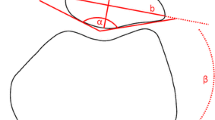Summary
In 60 autopsy knee joints findings on morphology and topography of medio- and suprapatellar plicae and level of insertion of the medial vastus muscle in relation to localization and degree of severity of chondromalacia were determined. The middle fields were affected most frequently and severely with 70% (chondromalacia class II and III). Thirty specimen with mediopatellar plica could be identified out of which 29 (97%) had class II or III chondromalacia; out of 30 specimen without a plica 18 (60%) showed chondromalacia. Accordingly a significant correlation could be detected between the incidence of chondromalacia and that of a mediopatellar synovial plica. When measuring the level of insertion of the medial vastus muscle class III chondromalacia showed an average level of insertion of 11%, class II of 22%, and class 0 or I of 30%. These differences are statistically significant. Patellar index, patellar facet angle, and patellar depth angle did not show any direct correlation to chondromalacia. The question arises whether the involution anomaly of the genicular septa and the muscular changes are not a manifestation of the same developmental disorder, thus creating the basis for an imbalance of the dynamic functional structure.
Zusammenfassung
An 60 Leichenkniegelenken wurden Befunde über Morphologie und Topographie der Plica medio- und suprapatellaris sowie der Ansatzhöhe des M. vastus medialis im Vergleich zur Lokalisation und Schweregrad der Chondromalazie erhoben. Am häufigsten und schwersten betroffen waren die mittleren Felder mit 70% (Chondromalazie II. und III. Grades). Es fanden sich 30 Präparate mit einer mediopatellaren Plica, davon hatten 29 (97%) eine Chondromalazie II. oder III. Grades; 30 Präparate hatten keine Plica, von ihnen wiesen 18 (60%) eine Chondromalazie auf. Es ließ sich demnach eine signifikante Abhängigkeit zwischen dem Vorkommen einer Chondromalazie and dem Auftreten einer Plica synovialis mediopatellaris feststellen. Bei der Vermessung der Ansatzhöhe des M. vastus medialis ergab sich für die Chondromalazie 111. Grades eine durchschnittliche Ansatzhöhe von 11%, beim Grad II von 22% and bei Grad 0 oder I von 30%. Diese Unterschiede sind ebenfalls signifikant. Der Patellaindex, der Patellafacettenwinkel und der Patellatiefenindex ließen keine direkte Beziehung zur Chondromalazie erkennen. Es wird die Frage aufgeworfen, ob die Rückbildungsanomalien der Kniesepten und die muskulären Veränderungen nicht Ausdruck derselben Entwicklungsstörung sind, womit Voraussetzungen für eine Störung des dynamischen Leistungsgefüges geschaffen werden.
Similar content being viewed by others
References
Andrews JR (1973) The suprapatellar plica and internel derangement. AAOS “Injured Knee in Sports”. Eugene/Oreg.
Andrews JR (1978) Editorial Comment. Am J Sports Med 6:224
Aoki T (1974) The ledge lesion in the knee. Proc 12th Congress Int Soc Orthop Surg Traumatology, Amsterdam 1973. Excerpta Med (Amst) Sect IXB 462
Bick EM (1930) Surgical pathology of synovial tissues. J Bone Jt Surg 12:33
Brattström H (1964) Shape of the intercondylar groove normally and in recurrent dislocation of patella. Acta Orthop Scand [Suppl] 68:5
Broukhim B, Fox JM, Blazina ME, Del Pizzo W, Hirsh L (1979) The synovial shelf syndrome. Clin Orthop 142:135
Ficat P, Bizou H (1967) Luxationes recidiventes de la rotule. Rev Chir Orthop 53:721
Fox JM, Blazina ME, Del Pizzo W, Ivey FM, Broukhim B, Hirsh L (1979) Medial synovial shelf syndrome. AAOS San Francisco, Cal. Abstract
Grueter H (1959) Untersuchungen zum Patellahinterwandschaden. Z Orthop 91:486
Hardaker WT, Whipple TL, Basset FH (1980) Diagnosis and treatment of the plica syndrome of the knee. J Bone Jt Surg 62:221
Hohlbaum J (1923) Die Bursa suprapatellaris und ihre Beziehungen zum Kniegelenk. Ein Beitrag zur Entwicklung der angeborenen Schleimbeutel. Bruns Beitr Klin Chir 128:481–498
Hughston JC, Whatley GS, Dodelin RA, Stone MM (1963) The role of the suprapatellar plica in internal derangement. Am J Orthop 5:25
Hughston JC, Andrews JR (1973) The suprapatellar plica and internal derangement. J Bone Jt Surg 55-A:1318
Klein W, Schulitz KP, Huth F (1979) Die Plica-Krankheit des Kniegelenkes. Dt Med Wschr 104:1261–1264
Iino S (1939) Normal arthroscopic findings in the knee joint in adult cadavers. J Jap Orthop Ass 14:462
Mayeda T (1918) Über das strangartige Gebilde in der Kniegelenkshöhle. Mitteilungen der Med Fakultät der Kaiserl Universität Tokyo 21:507–553
Mizumachi S, Kawashima W, Okamura T (1948) So called synovial shelf in the knee joint. J Jap Orthop Ass 25:22
Outerbridge RE (1961) The etiology of chondromalacia patellae. J Bone Jt Surg 43-B:752
Patel D (1978) Arthroscopy of the plicae — Synovial folds and their significance. Am J Sport Med 6:217
Pipkin G (1971) Knee injuries: The role of suprapatellar plica and suprapatellar bursa in simulating internal derangements. Clin Orthop 74:161
Sakakibara J (1976) Arthroscopic study on Iino's band (Plica synovialis mediopatellaris). J Jap Orthop Ass 50:513
Schulitz KP, Klein W (1980) Bedeutung der Rotationsinstabilität der Kniescheibe für die Entstehung der Chondromalazie. Orthop Praxis 16:481
Watanabe M, Takeda S, Ikeuchi H (1970) Atlas of arthroscopy. Igaku Shoin Ltd. Springer, Berlin Heidelberg New York
Wiberg G (1941) Roentgenographic and anatomic studies on the femoropatellar joint. Acta Orthop Scand 12:319
Author information
Authors and Affiliations
Rights and permissions
About this article
Cite this article
Schulitz, K.P., Hille, E. & Kochs, W. The importance of the mediopatellar synovial plica for chondromalacia patellae. Arch. Orth. Traum. Surg. 102, 37–44 (1983). https://doi.org/10.1007/BF00443037
Received:
Published:
Issue Date:
DOI: https://doi.org/10.1007/BF00443037




